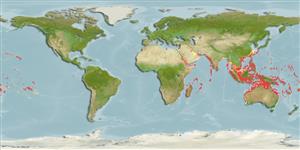Teleostei (teleosts) >
Mulliformes (Goatfishes) >
Mullidae (Goatfishes)
Etymology: Mulloidichthys: Latin, mullus = soft + Greek, ichthys = fish (Ref. 45335).
More on author: Lacepède.
Environment: milieu / climate zone / depth range / distribution range
Ecology
Marine; reef-associated; depth range 1 - 76 m (Ref. 90102). Tropical; 30°N - 37°S, 22°E - 124°W
Indo-Pacific: Persian Gulf (Ref. 80050); Red Sea and East Africa to the Hawaiian, Marquesan, and Ducie islands, north to the Ryukyu and Bonin Islands, south to Lord Howe and Rapa Islands. Common throughout most of its range (Ref. 9710).
Length at first maturity / Size / Weight / Age
Maturity: Lm 20.8, range 12 - ? cm
Max length : 43.0 cm TL male/unsexed; (Ref. 9710); common length : 25.0 cm TL male/unsexed; (Ref. 30573); max. published weight: 423.30 g (Ref. 121845)
Dorsal
spines
(total): 8;
Dorsal
soft rays
(total): 9;
Anal
spines: 1;
Anal
soft rays: 7. Back grey to olive, sides and belly whitish; 1-2 longitudinal yellow bands; dark blotch below 1st dorsal fin (Ref. 5405). Yellow-mid-lateral stripe from eye to tail and some yellow striping on cheek and along abdomen (Ref. 48636). Head length 3.1-3.5 in SL, length of snout 1.9.-2.2 and barbel 1.4-1.7 in HL. Body depth 3.7-4.8 in SL. (Ref. 90102)
Occasionally schooling species inhabit shallow sandy areas of lagoon and seaward reefs (Ref. 9710). Large adults are often found solitary on sand slopes with other species following to feed on prey that are disturbed when the goatfish is feeding (Ref. 48636). Benthopelagic (Ref. 58302). Feed on crustaceans, mollusks, worms, heart urchins and foraminiferans. Consumed fresh or dried. Minimum depth reported taken from Ref. 30874.
Myers, R.F., 1991. Micronesian reef fishes. Second Ed. Coral Graphics, Barrigada, Guam. 298 p. (Ref. 1602)
IUCN Red List Status (Ref. 130435)
Threat to humans
Reports of ciguatera poisoning (Ref. 130160)
Human uses
Fisheries: commercial; gamefish: yes; aquarium: commercial; bait: usually
More information
ReferencesAquacultureAquaculture profileStrainsGeneticsElectrophoresesHeritabilityDiseasesProcessingNutrientsMass conversion
Tools
Special reports
Download XML
Internet sources
Estimates based on models
Preferred temperature (Ref.
123201): 24.5 - 29, mean 27.8 °C (based on 1256 cells).
Phylogenetic diversity index (Ref.
82804): PD
50 = 0.5078 [Uniqueness, from 0.5 = low to 2.0 = high].
Bayesian length-weight: a=0.01072 (0.00936 - 0.01227), b=3.09 (3.05 - 3.13), in cm total length, based on LWR estimates for this species (Ref.
93245).
Trophic level (Ref.
69278): 3.8 ±0.3 se; based on diet studies.
Resilience (Ref.
120179): Medium, minimum population doubling time 1.4 - 4.4 years (K=0.16-0.27).
Prior r = 0.57, 95% CL = 0.37 - 0.85, Based on 2 stock assessments.
Fishing Vulnerability (Ref.
59153): Moderate vulnerability (39 of 100).
Climate Vulnerability (Ref.
125649): Moderate to high vulnerability (46 of 100).
Nutrients (Ref.
124155): Calcium = 41.7 [22.8, 67.6] mg/100g; Iron = 0.474 [0.224, 0.798] mg/100g; Protein = 18.8 [17.0, 20.5] %; Omega3 = 0.159 [0.108, 0.280] g/100g; Selenium = 34.4 [21.0, 57.4] μg/100g; VitaminA = 91.6 [32.7, 311.0] μg/100g; Zinc = 1.01 [0.64, 1.39] mg/100g (wet weight);
